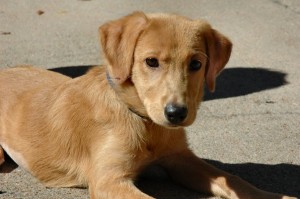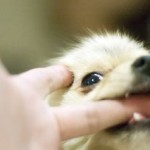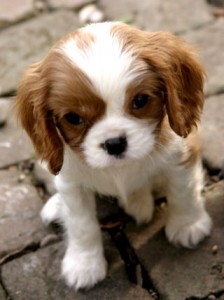Michael Baugh, CPDT-KA, CDBC
I used to say “potty training is easy.” What I really should say now is “potty training is not complicated.” That’s the first lesson I’ve learned from Stella (I’m sure there will be many). Potty training is not easy. It takes a great deal of work and attention. However, the idea of it is pretty darn simple.

Stella only has two states of existence right now: 1) safely confined and 2) interacting with a person (supervised). The confinement part is pretty easy. Stella actually seems to enjoy her quiet time in the crate. Some dogs fight this tooth and nail (some literally breaking teeth and nails). But Stella is cool with it. Of course, we can’t keep her in there all the time. So, the rest of the time she’s interacting with people under close supervision. And that takes a lot of work. In the first three hours of this morning Stella and I have been out for two potty breaks (more on those below), some play time, a potty break for me (yup she came with me), coffee and breakfast in the kitchen together (she ate too), and then some writing up in the office. She’s lying on her bed next to me, her leash attached to my desk, while she chews on a bone. I have not had a single waking moment without her by my side. I’m not complaining. But it is work.
That’s half of potty training – setting Stella up to win, making sure she doesn’t have the chance to poop or pee in the house. And after one week I can happily report that it’s working. Yes, there was one incident mid week when we had a lot of rain and she didn’t want to get her “princess fur” wet. Instead she got my kitchen floor wet. But we won’t focus on the negative. Her success to failure ratio is still phenomenal.
The other half of potty training is showing her that outside is the place to do it. And I mean the place. It’s simple but not always easy. In theory all you have to do is reinforce the puppy for going in the right spot. I recommend cheering, praising and then giving three treats one after the other as soon as the deed is done (immediately, don’t wait until you bring the puppy inside). Simple right?
But easy? Well, I found out pretty early on that Stella is not too keen on food when she’s outside. Some days she just outright refuses it. So I quickly had to remember the science of behavior. The training is not about the “treat.” It’s about whether or not the behavior changes. Clearly if Stella refuses food, then giving her a treat for going potty is not reinforcement. I needed something that would increase her “peeing outside” behavior and it wasn’t going to be food. Play. That’s a good one. Stella likes romping around and playing. Petting. That works for Stella too. So right after she goes I praise her enthusiastically, run around in circles getting her to play and I scritch (that’s a technical term) her chest. I look like a fool. But while the neighbors laugh I have a clean house.
On one of those rainy nights I knew all Stella wanted was to get back inside to dry her “princess fur.” Begrudgingly, she popped a squat and did her thing. In that brief moment I thought of the biggest jackpot prize I could come up with to reinforce her good behavior. It sure as heck wasn’t going to be a piece of kibble. It had to be bigger, something she could really use. So, as soon as her deed was done I laid it on her. “Good girl Stella, let’s go inside!” I was her hero. Smart girl. Smarter daddy.


